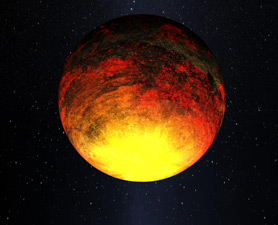 The rocky planet is the "missing link" in the search for worlds beyond our own.
The rocky planet is the "missing link" in the search for worlds beyond our own.
The first iron-clad proof of a rocky planet beyond the solar system has been found using the Kepler Space Telescope.
"It's the planetary missing link," said University of California-Berkeley astronomer Geoff Marcy, who likened the find to the development of penicillin and the discovery of DNA.
The rocky planet is the "missing link" in the search for worlds beyond our own.
The first iron-cl
ad proof of a rocky planet beyond the solar system has been found using the Kepler Space Telescope.

This illustration shows the new planet, Kepler-10b, overlooking its parent star
"It's the planetary missing link," said University of California-Berkeley astronomer Geoff Marcy, who likened the find to the development of penicillin and the discovery of DNA.
So far Marcy and other scientists have found more than 500 planets beyond the solar system, most of which are large gas worlds like Jupiter or Saturn. The planet-hunters' holy grail is to find a place like Earth.
Planet Green: Amazing Images of Earth From Space
Measuring just 1.4 times the size of Earth, Kepler-10b is in the ballpark, though this particular world is too hot for life as we know it. The planet circles 20 times closer to its parent star than Mercury orbits the sun and has a surface temperature of about 2,500 degrees Fahrenheit, close to the melting point of iron.
"Radiation prevents it from holding on to an atmosphere," said Kepler scientist Natalie Batalha, with
The planet might have been located farther away in a more hospitable region at some point in its past, or it may have evolved at its current location. Either way, it's not habitable now, says Marcy.
Its existence, however, is the first definitive proof that Earth-like worlds exist, scientists said.
The evidence, collected over eight months, comes from the slight but persistent shift in the amount of light coming from the parent star, a phenomenon caused by the periodic disappearance of the planet -- from Kepler's view -- as it orbits behind its star.
Kepler-10b makes the trip around its star in a day, providing an ample number of measurements for the Kepler team. Planets located at distances similar to Earth's distance from the sun -- planets more likely to support life -- take 365 days to transit around their parent stars, so more observations are needed.
What made the study of Kepler-10b so significant is that scientists were able to nail down the planet's size -- and thereby calculate its density -- with an unprecedented degree of accuracy.
"The amount of dimming... proves the diameter of the planet incontrovertibly," Marcy said. "The measurements nail down the mass of the planet without any question."
"The density is clearly higher than that of the Earth, making this a rocky planet, the first definitive rocky planet every found," Marcy said.

 Previous page
Previous page Back to top
Back to top







